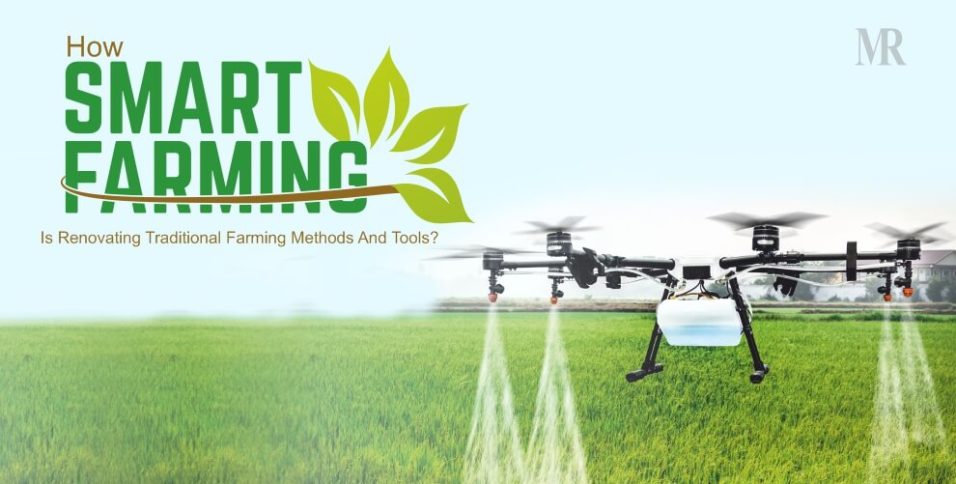In the hyper-digital environment, individuals are using electronic devices to stay connected with each other. The state-of-the-art technologies like artificial intelligence (AI), internet of things (IoT), machine learning (ML), big data, virtual reality (VR), etc. are disrupting various industries and transforming their traditional models into digital ones. Farming is one of the old forms of agriculture. This industry has witnessed some major technological transformations over the last few decades. From handheld tools and horse-drawn plows to machinery and chemical fertilizers to sensors and drones, traditional farming evolved and shifted towards technology-driven processes. Today, by using numerous smart agricultural tech innovations, farmers have gained better control over growing crops and maintaining livestock. This is a result of integrating AI, cloud, and IoT-powered systems in farming better known as Smart Farming.
What is Smart Farming?
Smart Farming is a combination of modern information and communication technologies (ICT) with traditional farming practices to enhance the quality and quantity of agricultural products. Currently, a number of technologies are used to digitize the farming processes including sensors and actuators, robotics, GPS, big data, drone, etc. By adopting smart farming, farmers can reduce the additional costs, increase crop yield, improve the production of crops, and lessen labor. Now that we have learned about what smart farming is, let’s take a look at its following applications.
Applications of Smart Farming
- Crop Management Devices and Livestock Farming
In traditional farming, farmers need labors for handling crops and livestock. As a result, they waste resources on unnecessary things. But, with IoT-powered system, the farmers can gather data specifically related to crop farming like temperature, rainfall, soil quality, etc. At the same time, they can monitor the health of livestock and adjust their nutrition accordingly. Through the analyzed data, they can identify whether the animals are sick or not as well as monitor crop’s health and nutrition needs. If animals are sick, they are isolated from others to prevent the spread of disease. If plants are not well, then additional nutrition can be supplemented to them. Gel fertilizers can be particularly effective in this context, providing a steady release of nutrients tailored to the specific needs of the crops. In this way, farmers can manage their field activities smartly and efficiently.
- Use of Agricultural Drones
Presently, farmers with their labors monitor the farm. However, they can gain better insights about their fields through drones. During the flight, the drones collect multispectral, thermal, and visual imagery. From this, farmers will receive the foresights on the plant health indices, plant counting and yield prediction, plant height measurement, nitrogen content in wheat, drainage mapping, weed pressure mapping, and so on. As a result, they would be able to focus on the lacking areas of their fields.
- Implementing Automation in Smart Greenhouses
Traditional greenhouses regulate environmental parameters through direct action or a method of proportional control that often leads to a production failure, energy loss, and increased labor costs. However, IoT-driven greenhouses smartly scrutinize and control the climate, which in turn removes human intervention. This can be further improved by integrating the system with cloud technology so that the generated data can be saved and processed at the same time in the cloud-storage. As a result, it will save time and cost.
- Automatic Planting and Seeding
In farming, sowing seeds is a tedious and difficult task. With advanced seeding machines or robots, the task of sowing seeds becomes easier. The seeding machines or robots come with geomapping and sensor data. This data consists of soil quality, density, moisture, and nutrient levels so that the seeds can grow in a health environment. Using this data, the machines or robots can plant the seeds in appropriate and conditioned places to grow healthily.
- Automatic Watering and Irrigation
A widespread irrigation method known as Subsurface Drip Irrigation (SDI) allows farmers to control when and how much water their crops can take. By incorporating these SDI systems with smart IoT-enabled sensors, farmers can continuously track moisture levels, plant health as well as intervene only when it is necessary.
Top 5 tips to consider before implementing smart farming
Smart devices and technologies have numerous ways to help farmers increase their farm’s performance and revenue. However, farmers face different set of challenges while thinking about investing in smart farming. Therefore, it becomes necessary to consider following 5 tips before implementing smart farming
- Farmers need to focus on what type of hardware will be required for collecting their farms’ data.
- They will require powerful data analytics capabilities. Along with this, predictive algorithms and machine learning will be needed for obtaining actionable insights based on the collected data.
- The purchased hardware should be durable and easy to maintain. Otherwise, farmers will need to replace the sensors more frequently.
- Remote access to the farms’ data will be available through smartphone and desktop computer. Therefore, they must know the nature of the applications.
- The system should be secured and safe to use so that there should be no possibility of data hacking.
In short, modern technologies such as AI, ML, IoT, and cloud computing are expected to advance the development along with introduction of more robots powered by AI into farming. However, there is still a lot of room for improvement in farming. In the upcoming years, the farming tools and models will completely embrace the digitization. In the coming days, smart farming will play a significant role in delivering more productive and sustainable agricultural products, which will be based on a resource-efficient and precision approach.
Also Read,





